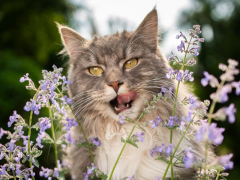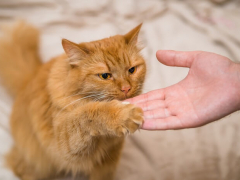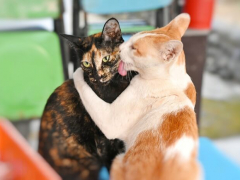
Pixel-Shot / Shutterstock.com
Spaying your cat is essential in ensuring your cat’s physical and mental health and well-being, as well as to prevent unwanted litters of kittens. The recovery process requires careful attention from cat parents and is overseen by the vet-led team to ensure a smooth healing journey.
Visual health checks of the incision. Keep eyes on the incision to ensure the area is healing without infection. Being aware of any behavioral changes. Some behavior changes are to be expected, but knowing how to navigate these changes can be beneficial. Provide a calm, stress-free environment. Limit physical activity to prevent reopening the wound. Follow your veterinarian’s instructions carefully. Stick to prescribed medications and the post-operative guidelines.Key Takeaways
You might decide to take some time off work for the first 48 hours to be around your cat as she recovers. Proper post-surgery care can minimize discomfort, prevent complications, and help your cat return to her regular daily routine and activities swiftly and safely.
Here are 10 practical tips for caring for your cat after her spaying procedure:
Spaying and the Healing Process
Spaying is a surgical procedure that removes a female cat’s ovaries and uterus. Although it is a routine procedure, it’s still a major surgery requiring proper aftercare. Most cats heal within 10 to 14 days, but complications can arise if care isn’t managed effectively.
Post-surgery, your cat might still feel woozy from the anesthesia, and the incision will need time to heal. During this recovery period, your attentiveness plays a critical role in helping your cat avoid discomfort and infection.
1. Monitor the Incision Site
One of the most critical aspects of care is a daily visual inspection of the incision on your cat’s belly for signs of infection. Look out for signs of the following:
- Redness, swelling, or discharge
- Unusual odor near the incision
- Excessive licking or biting at the site
Ensure the area is kept clean. Don’t apply any ointments unless directed by your vet. If you notice anything abnormal, contact your vet clinic immediately for advice.
2. Preventing Excessive Licking or Biting
Cats often want to lick their wounds, but licking the incision site can lead to infections or slow healing. Many vets recommend an Elizabethan collar (E-collar) or a soft recovery cone to prevent your cat from reaching the surgical area.
If your cat gets distressed and dislikes the traditional cone, consider alternatives like a recovery suit or an inflatable collar. These options can be more comfortable, but still prevent them from licking the incision. Purchasing an alternative before the surgery gives you options that are ready if they are needed.
3. Limit Physical Activity
Avoid picking up your cat unless absolutely necessary during the first few days post-surgery. If you need to lift them up, support their body carefully by holding their chest and rear legs, and avoid putting any pressure on the incision site.
Overactive behavior, like jumping or running, can cause the stitches to tear or the wound to reopen. Here are some ideas on how to minimize your cat’s activity:
- Confine your cat to a small, quiet room with limited furniture she can climb on
- Use playpens or baby gates to block off high-activity areas
- Provide soft blankets or beds to encourage rest
It is best to keep your cat indoors for at least 10 to 14 days after surgery. Outdoor exposure can increase the risk of infection or injury during recovery.
4. Only Administer Prescribed Medications

Kristina Savelieva / Shutterstock.com
Your veterinarian will likely prescribe pain medications or anti-inflammatories to keep your cat comfortable. Always follow the prescribed dosage and schedule. Never give your cat human over-the-counter medications, such as Tylenol, as these can be toxic to cats. If you’re unsure about how to administer medication without causing stress to your cat, ask your vet-led team for tips or a demonstration.
5. Maintain a Quiet, Stress-Free Environment
Cats recovering from surgery need peace and quiet to heal. Stress can slow recovery, so keep loud noises and disruptions to a minimum while maintaining their routine as much as possible.
Tips for a calm environment include:
- Create a dedicated recovery space with low lighting and soft bedding
- Limit interactions with other pets or young children
- Use synthetic cat pheromones to aid relaxation
6. Provide Easy Access to Welfare Needs
Make sure your cat has everything she needs within easy reach, such as:
- Wide, shallow food and water dishes
- A clean litter box with low sides for easy access and a loose soft substrate for easy digging
7. Feed Small, Frequent Meals
Anesthesia can affect your cat’s appetite, so start with small, easily digestible meals. Wet food is often preferred because it’s softer and more hydrating. You can encourage eating by warming the food up slightly to increase the aroma, as cats are driven to eat by their olfactory senses.
Contact your vet If your cat refuses to eat within 24 hours of surgery. Post-surgery nausea is common, but a prolonged lack of appetite can delay recovery or signal an underlying issue.
8. Keep the Incision Area Dry
Avoid bathing your cat or exposing the incision site to water until the stitches fully healed. Water can introduce bacteria to the wound and increase the risk of infection.
9. Follow Up with Your Veterinarian
Your vet will likely schedule a post-operative checkup to ensure your cat is healing properly and remove any stitches if needed. Attending this appointment and making your vet aware of any concerns you’ve noticed during recovery is crucial.
10. Watch Out for Behavioral Changes
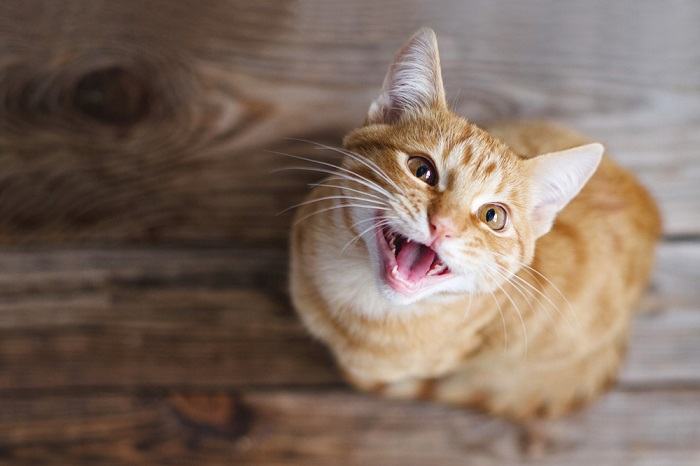
savitskaya iryna / Shutterstock.com
Cats commonly exhibit behavioral changes after surgery, driven by physical discomfort, hormonal shifts, and the effects of anesthesia. Awareness of these potential behaviors is essential for their recovery and overall well-being. Here are some behavioral changes to look out for and address:
Post-Anesthesia Disorientation
After surgery, cats often appear lethargic due to the lingering effects of anesthesia. This is normal and should subside within 24 hours.
How to Support:
- Provide a calm, dimly lit environment to help your cat rest and recover.
- Avoid loud noises or sudden movements, as these might startle your cat.
Increased Vocalization
Your cat might meow more than usual after being spayed. This could be due to discomfort, confusion, or seeking attention.
How to Support:
- Sit near your cat and speak to her in a soothing tone to reassure her.
- Ensure she has everything she needs, such as food, water, and a quiet, safe, comfortable place to rest.
Restlessness or Hyperactivity
Some cats might experience restlessness or bursts of energy during recovery. This can be concerning, as excessive activity risks reopening the incision.
How to Support:
- Use foraging mats and toys to engage their mind without encouraging physical activity. DIY foragers are easy to make from household items such as cardboard tubes with holes cut into them. Avoid anything with a catnip as that is a stimulant.
- Confine them to a smaller area with minimal opportunities for jumping or climbing. Stacked baby gates or a mesh door can limit their access to the rest of the home, but they can still see their environment.
Temporary Withdrawal or Hiding
It’s instinctive for cats to seek solitude while recovering, as they might feel vulnerable or stressed. This behavior is usually temporary; prolonged hiding might signal discomfort or anxiety.
How to Support:
- Check on your cat periodically, but give her space if she prefers to be alone. Providing a cardboard box for them to hide in is useful, as you can control the position of their safe space rather than under a bed, which might prove difficult to check on their well-being.
- Introduce calming pheromones with a plug-in device or sprayed onto their favorite blanket to make their hiding spot more inviting.
Increased Affection or Neediness
Some cats might become more affectionate or clingy after spaying. This could result from seeking comfort or reassurance from their human caregivers.
How to Support:
- Offer gentle petting if your cat seeks it; keep this to the head, facial, and upper body area, avoiding the abdomen.
- Spend extra time with your cat to help her feel secure, but avoid overhandling or overstimulating her. If you have to leave her for a time, make sure the environment is warm and a reassuring radio is left on playing calming music in a low volume setting.
Other Changes
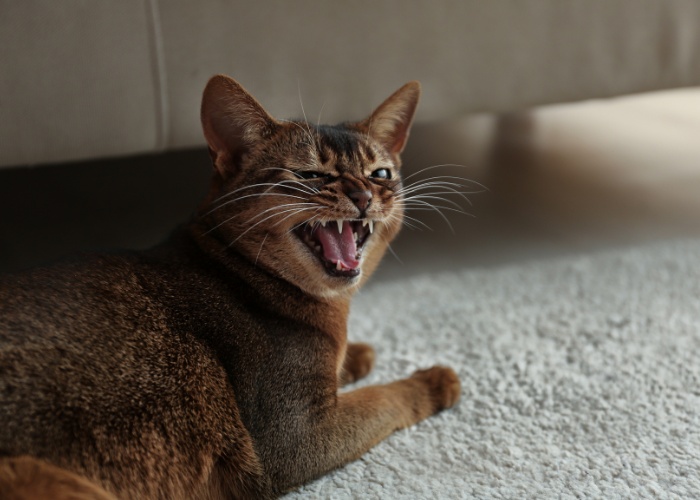
New Africa / Shutterstock.com
Behavioral shifts in eating habits are common post-surgery. Cats might eat less initially due to nausea but usually show increased hunger once they feel better.
It’s normal for your cat to be less active or appear tired after surgery, but certain behavioral changes might indicate a problem, such as:
- Hiding or excessive vocalization.
- Difficulty moving or walking unsteadily (ataxia).
- Aggression or irritability when touched. Cats in pain might exhibit signs of irritability or aggression, such as hissing, swatting, or avoiding touch.
Caring for a cat after spaying requires planning, patience, attention, and a calm environment. Following these practical tips can help your cat recover quickly and avoid complications.
Remember, every cat is unique in the way they will react and heal—monitor your cat’s behavior closely, and don’t hesitate to contact your veterinary clinic if you’re unsure about any aspect of her recovery.




